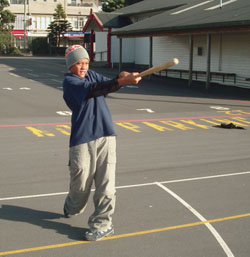The students were presented with a list of seven activities that
they might do in physical education at school, and were asked to
tick up to three activities that they most like to do. Compared
to Mäori students in general education, students in Mäori
immersion settings were similarly and highly enthusiastic about
ball activities, dramatically less enthusiastic about athletics,
substantially more enthusiastic about swimming, and somewhat more
enthusiastic about gymnastics, dance, and te reo kori. |
FAVOURITE
ACTIVITIES
|
%
responses |
| GEd |
MI |
ball
activities |
67 |
69 |
athletics
|
44 |
2 |
swimming/aquatics
|
29 |
49 |
fitness
|
27 |
31 |
gymnastics
|
21 |
33 |
dance
|
19 |
31 |
te
reo kori (Mäori activities) |
16 |
29 |
|
| The
students were then presented with a list of six ways of doing physical
education activities, and were asked to tick up to three ways that
they liked. The responses are shown adjacent, ordered from most
to least popular for year 8 students. The patterns are very similar
for Mäori students in general education and students in Mäori
immersion settings. |
FAVOURITE
APPROACHES TO PHYSICAL EDUCATION
|
%
responses |
| GEd |
MI |
class
games |
56 |
60 |
doing
things in teams |
54 |
51 |
school
sports days |
47 |
51 |
playing
for fun
(not winning or losing) |
43 |
40 |
competitions
(winning or losing) |
40 |
40 |
doing
things on your own |
12 |
22 |
|
|
 When
asked to write down up to three very important things a person needs
to learn or do to be good in physical education, Mäori students
in general education emphasized fitness most, followed by three almost
equally popular options: good sportsmanship, positive attitudes and
effort, and physical or game skills. Students in Mäori immersion
settings emphasized physical or game skills most, followed in turn by
training/practising, fitness, and good sportsmanship. When
asked to write down up to three very important things a person needs
to learn or do to be good in physical education, Mäori students
in general education emphasized fitness most, followed by three almost
equally popular options: good sportsmanship, positive attitudes and
effort, and physical or game skills. Students in Mäori immersion
settings emphasized physical or game skills most, followed in turn by
training/practising, fitness, and good sportsmanship.
When asked to write down three really important things they had learned
in physical education, large majorities of both groups mentioned the
rules, techniques or skills of particular activities or games. For Mäori
students in general education good sportsmanship, cooperating with others,
and positive attitudes or effort came next, while for students in Mäori
immersion settings fitness, training/practising, and warm-ups/stretches
came next.
Responses to the 9 rating items are presented below. Compared to Mäori
students in general education, students in Mäori immersion settings
were equally positive about physical education at school and in their
own time and about equally physically active over the 24 hours preceding
the survey. They were somewhat less enthusiastic about increasing the
amount of physical education at school and about continuing physical
education when they were older, but were somewhat more positive about
their own ability and how their teacher and family viewed their ability.
|